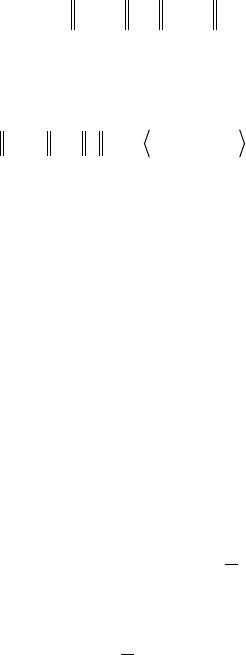 Journal of Applied Mathematics and Physics, 2014, 2, 21-25 Published Online January 2014 (http://www.scirp.org/journal/jamp) http://dx.doi.org/10.4236/jamp.2014.21004 OPEN ACCESS JAMP Approximative Method of Fixed Point for Φ-Pseudocontractive Operator and an Application to Equation with Accretive Operator Yixin Wen, Aifang Feng, Yuguang Xu Department of Mathematics, Kunming University, Kunming, China Email: donwen-620@163.com Received October 2013 ABSTRACT In this paper, Φ-pseudo-contractive operators and Φ-accretive operators, more general than the strongly pseu- do-contractive operators and strongly accretive operators, are introduced. By setting up a new inequality, au- thors proved that if is a uniformly continuous Φ-pseudo-contractive operator then T has unique fixed point q and the Mann iterative sequence with random errors approximates to q. As an application, the iterative solution of nonlinear equation with Φ-accretive operator is obtained. The results presented in this paper improve and generalize some corresponding results in recent literature. KEYWORDS Duality Mapping; Φ-Pseudo-Contractive Operator; Φ-Accretive Operator; Mann Iterative Sequence with Random Error Terms 1. Introduction and Preliminaries In 1994, Chidume [1] solved a problem dealt with the fixed point for the class of Lipschitz strictly (strongly) pseudo-contractive operators in uniformly smooth Banach space . That is, he proved that the Ishikawa itera- tive sequence converges strongly to the unique fixed point of in where and is Lipschitz strictly (strongly) pseudo-contractive. Chang [2], in 1998, improved the result, i.e., he proved that the conclusion of Chidume holds if T is uniformly continuous and the fixed point set of T is nonempty (i.e., ). Recently, Liu [3] proved, if the strongly pseudocontractive operators are replaced by the more general -strongly pseudo-contractive operators then the conclusion of Chidume still holds. The objective of this paper is to introduce Φ-pseudo-contractive operators—a class of operators which are more general than the -strongly pseudo-contractive operators and to study the problems of existence, unique- ness and the iterative approximate method of fixed point by setting up a new inequality in arbitrary Banach space. As an application, the iterative solution of nonlinear equation with Φ-accretive operator is obtained. The results presented in this paper improve and generalize the conclusions of Chidame, Chang and Liu. To set the framework, we recall some basic notations as follows. Throughout this paper, we assume that is a real Banach space with dual , denotes the genera- lized duality pairing. The mapping defined by ( ) { } = :,,JxjXx jxjjxxX ∗ ∈== ∀∈ (1) is called the normalized duality mapping [4]. Now, we introduce Φ-pseudo-contractive operators as follows. Definition 1. Let be nonempty subset of X. An operator is said to be Φ-pseudo-contractive, if there exists a strictly increasing function with and such that  Y. X. WEN ET AL. OPEN ACCESS JAMP ( ) ( ) ( ) 2 ,,TxTyjxyxyxy xyK Φ −−≤−−−∀∈ . (2) An operator is said to be Φ-accretive, if ( ) ( ) ( ) ,,Ax Ayjx yx yxyK Φ −− ≥−∀∈ . (3) It is easy to verify that the operator is Φ-pseudo-accretive if and only if is Φ-accretive where is an identity mapping on . Hence, the mapping theory for accretive operators is intimately connected with the fixed point theory for pseudo-contractive operators. We like to point out: every strongly pseudo-contractive operator is -strongly pseudo-contractive with defined by where , and every -strongly pseudo-contractive operator must be the Φ-pseudo-contractive operator with defined by . Obviously, if a Φ-pseudo-contractive operator has a fixed point then it is unique. Definition 2. Let be an operator. For any given the sequence defined by ( ) ( ) 1 10 nnnnnnn xxTxu n ααγ + =−++≥ (4) is called Mann iteration sequence with random errors. Here is a bounded sequence in and is said random error terms of iterative process, and the parameters and both are sequences in . By the way, Xu introduced another definition of Mann iterative sequence with random errors in [5]. In particular, the parameters for all in Equation (4) then is called Mann [6] iteration sequence. 2. Main Results First, we have an existence theorem of fixed point as follow. Theorem 1. If is a continuous Φ-pseudo-contractive operator with bounded range then has an unique fixed point in . Proof. Define by where and . Note that is Φ-pseudo-contractive, thus ( ) ( ) ( ) ( ) ( ) ( ) ( ) 2 2 ,, 1 nn n nn n TxTyjxyxy cTxTyjxy c xycxy c xy Φ Φ −−=−− −− ≥−− +− ≥− (5) for all and some . Clearly, is a continuous strongly accretive operator. It follows from the Theorem 13.1 of Deimling [7] that there exists an such that for any . Next, the sequence is bounded. In fact, if then for all and ( ) limlim 10 nn nn nn xTxc Tx →∞ →∞ −= −= (6) Since is Φ-pseudo-contractive, that is, is Φ-accretive, so ( ) ( )( ) ( ) ( ) ( ) ( ) , 2 mkmk mk mk mkmk mm kk xxITxI Txjxx x Txx Txxx M xTxxTx Φ −≤ −−−− ≤− +−− ≤− +− (7) for any . Equations of (6) and (7) ensure that is a Cauchy sequence. Consequently, converges to some . By the continuity of we have 1 nn nn n Tqlim Txlimxq c →∞ →∞ = == . Suppose that there exists a such that then  Y. X. WEN ET AL. OPEN ACCESS JAMP 23 ( ) ( ) ( ) 2, =0qq qq TqTqjqq Φ ∗ ∗∗∗ −≤−−−− which means that . i.e., is unique fixed point of . The proof is completed. The following two Lemmas will play crucial roles in the proof of Theorem 2. Lemma 1. [2] If be a real Banach space then there exists such that ( ) 22 2, ,xyxyjxy xyX+ ≤++∀∈ . (8) Second, to set up a new inequality as follows. Lemma 2. Let be a strictly increasing function with and let and be two nonnegative real sequences satisfying ,and lin nn n n cb b →∞ <∞ =∞ ∑∑ . (9) Suppose is a nonnegative real sequences. If there exists a integer satisfying ( )() 22 1 10nnnnnn aaobcban N Φ ++ ≤++ −∀≥ (10) then . Proof. Let . If , then for all . From the conditions of Equation (9) there exists an integer 0 such that . (11) So, we have ( ) 22 1 1Φ 2 n nnn aacb nN σ + ≤+ −∀≥ . By induction, we obtain ( ) 2 == 1Φ 2 jN j jN jN ba c σ +∞ +∞ ≤+≤ +∞ ∑∑ . (12) Equation (12) is in contradiction with . It implies that . Therefore, there exists a subse- quence { } j ⊂ such that . So, for any given there exists an integer such that ( ) ( ) 0 0 0 j n nnn j ajj and obcbn n ε ε <∀≥ +≤Φ∀ ≥> . (13) If is fixed, we will prove that for all integers . The proof is by induction. For , suppose . It follows from Equations (10) and (13) that ( ) ( ) 000 000 2222 2 1 Φ jjj jjj nnn nnn aa obcba ε εε + ≤≤++−≤< . It is a contradiction. Hence, holds for . Assume now that for some integer . We prove that . Again, assuming the contrary, Using Equations (10) and (13), as above, it leads to a contradiction as follows ( ) ( ) +1 0 00 00 0 22 2 22 np j jj jj np j nnpnpnp a a obcb a ε ε ε + + ++ + ≤ ≤ ++−Φ ≤< Where . Therefore, holds for all integers , i.e., 0 lin lin0 j n nk nn aa + →∞ →∞ = = The Proof is completed.  Y. X. WEN ET AL. OPEN ACCESS JAMP Theorem 2. Let be an → a uniformly continuous Φ-pseudo-contractive operator with bounded range. Suppose that the iterative sequence is defined by Equation (4) satisfying ,lin0 and nn n n . γα α →∞ <∞ ==∞ ∑∑ (14) then converges strongly to unique fixed point of . Proof. From Theorem 1, we know that there exists a unique fixed point of . Putting { } { } 00 : :0 n Msup TxxXsupunx=∈ +≥+ for any given , then . Using induction, we have for all . Let . Since ( ) 1 20 n nnnnn xxaxTxMasn α + −=− ≤→→∞ , therefore, by the uniformly continuity of . From Equation (14) there exists an integer such that . (15) By Equations (4), (8) and (15) we have ()() () ( )( ) ( ) ( ) ( ) ( ) ( ) ( ) ( ) ( ) ( ) ( ) 2 2 1 22 1 1 22 11 2 1 222 21 21 222 1 1+2 , 2, 1 2, 2, 2 1 2+2 2 22 23 2 nn nnnnn n nnnn nn n nn nn nn nn nn n nnnn nnnn n nn nn x qxqaTxqu xqu jxq Txq j xq xq TxTxjxq Txq j xqM xqxq Me Mxq x qMMe αγ αγ α α α αγ αα α α γα αα + + + ++ + + + −= −−+−+ ≤− −− +− − ≤− − +− − + −−+ ≤− +−− ++−Φ − ≤−+ ++ ( ) ( ) ( ) 21 2 1 Φ Φ nnn nnnnn M xq xq ocxq γα αα + + −− = −++−− (16) for all where and . It follows from the Lemma 2 that . The Proof is completed. Last, as an application, the existence, the uniqueness and the approximate method of solution of nonlinear equation with Φ-accretive operator is obtained. That is Theorem 3. Suppose that is an → a uniformly continuous Φ-accretive operator and the range of either or be bounded. For any given , the equation has unique solution in , and if is defined by ( )()() 1 10 n nn xxfIAxu n αα γ + =− ++−+≥ satisfying the conditions of equation (14) then it converges strongly to the solution. Proof. We define by for all . Clearly, is Φ-pseudo-contractive and continuous if is Φ-accretive and continuous, and the range of is bounded if is. It is easy to see that is a solution of the equation if and only if that is a fixed point of . It follows from the Theorem 2 that has an unique solution and the iterative sequence is defined by Equa- tion (4) converges strongly to . i.e., the sequence is an iterative solution of the equation . The proof is completed.  Y. X. WEN ET AL. OPEN ACCESS JAMP 25 Remark. Theorem 2 improves a number of results (for example, Theorem 4.2 of [2], Theorem 2 of [1] and Corollary 3.3 and 3.4 of [3]) in the following senses. 1) The existence and the convergence of the fixed point for Φ-pseudo-contractive operator are studied simul- taneously. 2) The operators may not be strongly pseudo-contractive or -strongly pseudo-contractive. 3) The continuity of operator may not be Lipschitzian. 4) The errors come from the iterative process have been considered appropriately. REFERENCES [1] C. E. Chidume, “Approximation of Fixed Points of Strongly Pseudo-Contractive Mappings,” Proceedings of the American Mathematical Society, Vol. 120, 1994, pp. 545-551. http://dx.doi.org/10.1090/S0002-9939-1994-1165050-6 [2] S. S. Chang, Y. J. Cho and B. S. Lee, “Iterative Approximations of Fixed Points and Solutions for Strongly Accretive and Strongly Pseudo-Contractive Mappings in Banach Spaces,” Journal of Mathematical Analysis and Applications, Vol. 224, 1998, pp. 149-165. http://dx.doi.org/10.1006/jmaa.1998.5993 [3] Z. Q. Liu, M. Bounias and S. M. Kang, “Iterative Approximations of Solutions to Nonlinear Equations of -Strongly Accre- tive in Banach Spaces,” Rocky Mountain Journal of Mathematics, Vol. 32, 2002, pp. 981-997. [4] E. Asplund, “Positivity of Duality Mappings,” American Mathematical Society, Vol. 73, 1967, pp. 200-203. http://dx.doi.org/10.1090/S0002-9904-1967-11678-1 [5] Y. G. Xu, “Ishikawa and Mann Iterative Processes with Errors for Nonlinear Strongly Accretive Operator Equations,” Journal of Mathematical Analysis and Applications, Vol. 224, 1998, pp. 91-101. http://dx.doi.org/10.1006/jmaa.1998.5987 [6] W. R. Mann, “Mean Value Methods in Iteration,” Proceedings of the American Mathematical Society, Vol. 4, 1953, pp. 506- 510. http://dx.doi.org/10.1090/S0002-9939-1953-0054846-3 [7] K. Deimling, “Nonlinear Functional Analysis,” Springer-Verlag, Berlin, 1985. http://dx.doi.org/10.1007/978-3-662-00547-7
|